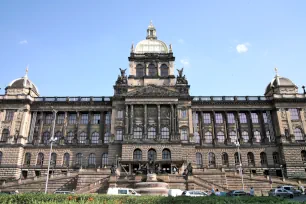Wenceslas square was originally conceived in the fourteenth century as a horse market. The large square, measuring 750 by 60 meters (2,500 x 200 ft.), evolved into Prague’s central boulevard.
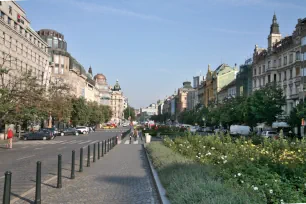
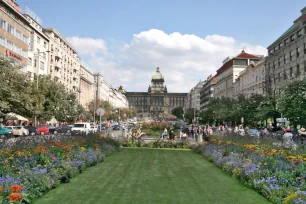
The square was created in 1348 as part of Emperor Charles IV’s plan for Nové Město (New Town), a large new town that was three times the size of Staré Město (Old Town).
The new town had unusually large, wide streets and three large market squares. One of these, the horse market, formed the heart of New Town. In the nineteenth century this square was named Wenceslas Square after the patron saint of Bohemia, Saint Wenceslas. The nineteenth century also saw the construction of large, stately buildings along the square.
Today, Wenceslas Square forms the commercial heart of Prague. It is a popular meeting place and the many hotels, shops and restaurants around the square attract throngs of tourists and locals alike.
Historical Events
Many of the important historical events in Prague’s recent history took place here, such as the declaration of the First Republic in 1918, the protests against the Soviet occupation in 1969 and the protest march in 1989 which led to the Velvet Revolution and the end of the Communist era.
National Museum
The long, pedestrian friendly square leads uphill towards the National Museum, a monumental Neo-Renaissance building constructed by Josef Schultz in 1890. The museum building replaced the Gate of Saint Procopius, commonly known as the Horse Gate. This gate, which was part of a long defensive wall around New Town, was demolished in 1875. The museum building is one of Prague’s most iconic buildings, and its dome dominates the surroundings.
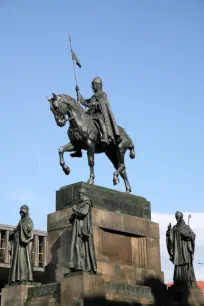
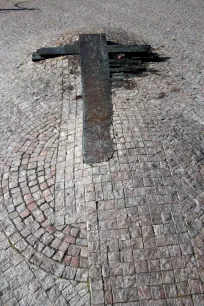
St. Wenceslas Monument
In front of the museum stands the ‘Pomnik svatého Václava’, an equestrian statue of Saint Wenceslas. Wenceslas, ‘the good king’ was a Bohemian duke spreading Christianity. Murdered in 929 by his brother, he was later declared a saint and eventually became a national Czech symbol.
Already in the seventeenth century a statue of Wenceslas stood nearby at the top of the hill, but in 1879 it was moved to Vyšehrad. In 1894 a competition – only open to Bohemian artists – was organized to create a new statue.
After much deliberation, a design by Josef Václav Myslbek – which shows the saint in full armor astride a horse – was selected. The bronze statue was unveiled in 1912. Four statues at the foot of the pedestal show more Bohemian saints: Ludmilla (grandmother of Wenceslas), Agnes, Procopius and Adalbert.
Memorial to Jan Palach and Jan Zajíc
Not far from the monument of St. Wenceslas, Jan Palach set himself on fire to protest the Soviet occupation in January 1969. His example was followed a month later by another student, Jan Zajíc. A small memorial in front of the National Museum commemorates Palach and Zajíc, as well as other victims of the Soviet occupation.
Art Nouveau Architecture
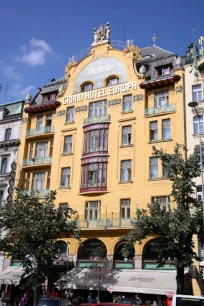
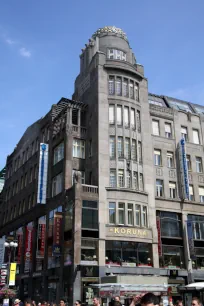
Most of the grandest buildings that line Wenceslas Square were built at the start of the twentieth century. The square contains some nice examples of Art Nouveau architecture, locally known as Secese. The style was very popular at the beginning of the twentieth century, when the square was being redeveloped.
The most famous of those buildings is the Grand Hotel Evropa, constructed between 1903 and 1906. The building has a beautiful facade topped with a gilded sculpture group of nymphs. Nearby is the Palác Lucerna, built between 1907 and 1921, when Art Nouveau was on its last legs. It was built by Vácslav Havel, whose grandson Václav would later become president. Inside is the Lucerna Passage, a shopping arcade with a palatial interior.
Another impressive Art Nouveau building is the Palác Koruna (Crown Palace), built in 1914 by Antonín Pfeiffer for an insurance company. At the corner of Štěpánská stands an even more monumental Art Nouveau structure: the Šupichovy domy, built between 1913 and 1916 by Emil Králíček and Matej Blecha. From the same architects is the more refined Hotel Zlatá Husa, from 1920.
More modern buildings on Wenceslas Square failed to reproduce the grandeur of the Art Nouveau buildings. There is, however, one more interesting building that catches the attention of passers-by: the Wiehlův dům (Wiehl House). It was built in 1896 by Antonín Wiehl in a Neo-Renaissance style. Its front facade is magnificently decorated with frescoes created by Mikoláš Aleš.


